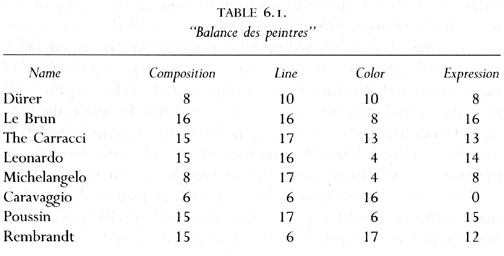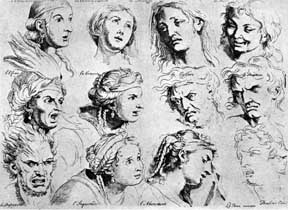The French Academy in the 17th Century
(The following is taken from Nicolas Pevsner, Academies of Art Past and Present, Cambridge: Cambridge University Press, 1940)
Some details may now be given as to the curriculum of the academy. One fact should be clearly understood, to begin with, and that is that the Paris academy was never meant to deal with the whole of the professional education of a young painter or sculptor. He neither painted nor carved nor modelled figures or reliefs during his working hours at the academy. All this he had to learn in the studio, or, as one may safely say, the workshop of his master, with whom he still lived and under whom he still worked, in a way almost exactly identical with that of the Middle Ages.
The rules of 1663 allowed each academician to teach six pupils. Nobody was admitted as a student to the academy, unless he could produce a certificate from his master. The course at the academy was divided into a lower and higher class. In the lower class, the Salle du Dessin, students had to copy from the drawings of the professors, the upper class did only or mainly life-drawing. It is not quite clear whether drawing from plaster casts and originals of classical sculpture was regarded as part of the elementary or the advanced course.
The sequence of drawing from drawings, drawing from casts, drawing from the living model was regarded as the foundation of the academic curriculum. It remained valid right through the eighteenth and far into the nineteenth century. In addition, lectures on perspective, geometry and anatomy were given, and a reference library was gradually built up.
Besides drawing, classes were also given in perspective or geometry. Also given were discourses, which were to be delivered at the business meetings before an audience of members as well as students. In this the example of Federico Zuccari's lectures in Rome is evident.
The discourses of the Paris academy had evidently above all educational aims. This distinguishes them from Zuccari's lectures, which were to be given by accomplished artists to accomplished artists in order to produce by mutual help and discussion a clear understanding of Art and its principles. The purpose of the lectures was to provide "préceptes positifs." These precepts should be laid down in writing and printed for the benefit of the young.
It had been Charles Lebrun's idea to supply with the aid of the discourses definite rules for young artists. Never before has a known period had so unswerving a faith in clear, mathematically provable rules and in arguments throughout accessible to reason as the golden age of Absolutism. One passage at least must be quoted to demonstrate the expression of this faith in the theory of art. Fréart de Chambray in his Idée de la Perfection de la Peinture (1662) calls Scavants, i.e. real art experts, only those who "examinent et jugent les choses à la manière des Géomètres."
In order to facilitate such exact judgments on a work of art, the usual procedure in the academic lectures as well as the contemporary books was to analyse a picture - it was usually one from the royal collections - according to various categories to be discussed one after another. Nobody seems to have raised any objection to this dissecting method, and consequently no one can have had any feeling for the spiritual oneness of the artist's creative activity, or of its product.
One should recall the fact that this change of aesthetic outlook did not take place until the second half of the eighteenth century, before one interprets and passes sentence upon the works of Lebrun and his followers according to criteria not in existence at their time. Fréart's categories are
1. invention
2. proportion
3. colour
4. expression
5. composition
Lebrun analysed Poussin's pictures in his academic lectures according to very similar categories. The final stage of this system is reached by Testelin, the secretary of the academy, in his Tables de Préceptes published in 1680, in which he briefly sums up all the rules laid down by the academy, and by Roger de Piles in his Balance des Peintres of 1708, the notorious book, in which marks from 0-20 are given to all famous painters according to the value of their composition, expression, design (drawing) and colour.

Roger de Piles, Balance des Peintres,
(from Cours de Peintre par Principe, 1708)
Invention was to be noble, and Lebrun considered the presence of such vulgar beasts as the camels in Poussin's Eliezer and Rebecca, or ox and ass in Annibale Carracci's Adoration of the Shepherds, an offence against this rule. The subject of a picture should also have a didactic value. Therefore, just as amongst Mannerists in the 16th century, allegories of all kinds ("tableaux enigmatiques", Félibien) were especially appreciated.
Another consequence of the same principle was the contempt of all "genres mineurs", i.e. anything that did not come under the heading of "Histoire". In Félibien's book a scale of value of the various subjects in painting can be found, which widely influenced the generations to follow. Still-lifes are at the bottom of the scale, landscapes are slightly preferable, pictures of animals range higher by another grade, because they treat of a higher form of life. As superior as humanity to the world of the animals is the portrait to the animal piece. Histories, however, are of necessity far more valuable than the realistic presentation of individual beings.

Charles Le Brun, The Expressions
(from Traité des Passions, 1698)
As for the category of expression, this seemed - at the instance of Descartes's psychology - an especially promising field of discussion. Again Lebrun goes farther than anybody in his elaborate description and analysis of the various shapes of faces and expressions corresponding to different characters and moods.
Proportion remained completely under the guidance of the canons of Antiquity. Poussin set the example by his measurings of Roman statues, which Bellori later published.
Up to the 1670s, Antiquity was moreover the unchallenged pattern for most of the attitudes and gestures in painting. Even nature had to be corrected, if she did not tally with Greek and Roman sculptures. Rome was considered more essential to the creation of a perfect work of art than Nature.
In close connection with this is the thesis of the ascendency of outline (=trait or dessin) over colour. Drawing is called by Lebrun "le pôle et la boussole qui nous règle", and by Félibien "la premiére (partie) et la plus essentielle de la peinture".
Colour, on the other hand, ranges in Dufresnoy's book as a mere "supplementum graphidis." These few quotations on the theory of art from French authors may serve to give an idea of the principles underlying the academic tuition in lectures and the drawing classes.
The Académie Royale de Peinture et de Sculpture operated under strict rules and regulations. The life-class had to be attended from 6 to 8 in the morning during the Summer months, and from 3 to 5 in the afternoon ("à la lampe") in the Winter. Students were also encouraged to draw in the rooms of the academy at other times, particularly from the existing plaster casts. Perspective was taught on Wednesday and Saturday mornings, anatomy also on Saturdays. Lessons were not given free, although this had been planned.
During the earliest decades pupils of academicians had to pay 5 sous per week. Sons of academicians were at first exempt from fees. That the transmission of the artistic profession from father to son was considered so much a matter of course shows how far we still are from the conception of art and artist which predominated in the nineteenth century. Fees for masters and sons of masters were fixed in 1656 at 10 sous as against 5 sous for the sons of academicians. It was only in 1683 that the academy was ordered to drop fees entirely. The new system first worked in 1684 and soon complaints appeared about overcrowding in the life-class.
In 1689 a monthly examination of all the drawings done in the academy was suggested, in order to eliminate unsuitable students or at least to move them back to the elementary class. While this proposal as well as the entrance certificate from an academician which was required for being admitted to the academy were to act as a protection against the influx of inferior talents, royal scholarships had been introduced as a help for those exceptionally talented but poor. There were ten scholarships in 1689. The number was however reduced to five in 1696 because of the political troubles of 1693 and the following years - unlucky warfare, famine and discontent. The same reason probably accounts for the reintroduction of fees in 1699, although it is not quite clear whether they had ever really been given up.
Amongst the advantages of the academy which ranged highest in the mind of the students was no doubt the exemption from military service; amongst those most valuable to the institution itself was the life-drawing monopoly. It seems almost impossible actually to enforce a decree of this kind, and yet we find in 1662 and again in 1677 that students were warned and fined because they had combined to hire a model and draw from the nude.
A particularly conspicuous feature of academic life was the prize-giving celebrations held at regular intervals. Here again the idea was derived from Rome and only systematized in Paris. At first, prizes were simply a reduction or remission of fees. Later, medals were distributed four times a year as Petits Prix, and once a year a Grand Prix was offered. To compete for this was, however, the privilege of only a small selection of students.
A preliminary sifting-out took place based on examination drawings done in the presence of academicians. Those who had passed this first test were allowed to submit a sketch interpreting a given (usually biblical) theme. On the strength of the sketches, the candidates were chosen for the final test, which consisted of carrying out a picture or relief from the sketch while in a locked cell within the academy. A public exhibition of the works thus produced was held, criticism was invited, and at long last the council chose the student worthy of the highest award. An extremely Baroque procedure, cumbrous and of an intricate, as it were, pyramidal gradation.
Besides the exhibitions of students' prize drawings, there were also exhibitions of works done by the members of the academy. The first of these were held in 1667 and 1669, but here no real regularity was as yet attained. Only ten exhibitions during Louis XIV's reign are recorded (and in these exhibitions began the gradual evolution of the Paris Salons).
The crowning award for a student, an award beyond even the Grand Prix, was the Prix de Rome, i.e. a scholarship usually for four years to live at the Académie de France in Rome. This branch of the Paris academy - for it can be called that, although in the time of Louis XIV not only students from the Académie Royale but also quite frequently proteges of influential courtiers were granted scholarships - was inaugurated in 1666. Rome meant fullness of experience first and foremost, the thrill of an unsophisticated life, and of art happily blended with such a life. Lessons in mathematics and anatomy were also provided, at first even with specially appointed teachers. When the four years of a Rome scholar had come to an end, he would return to France to take up a career as an artist.
|
|

